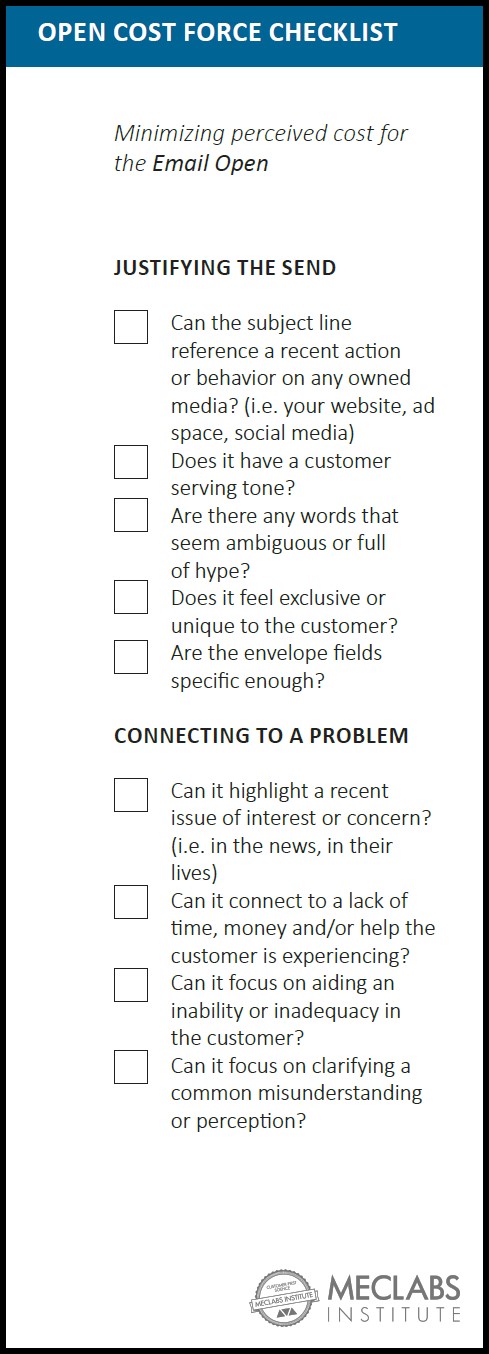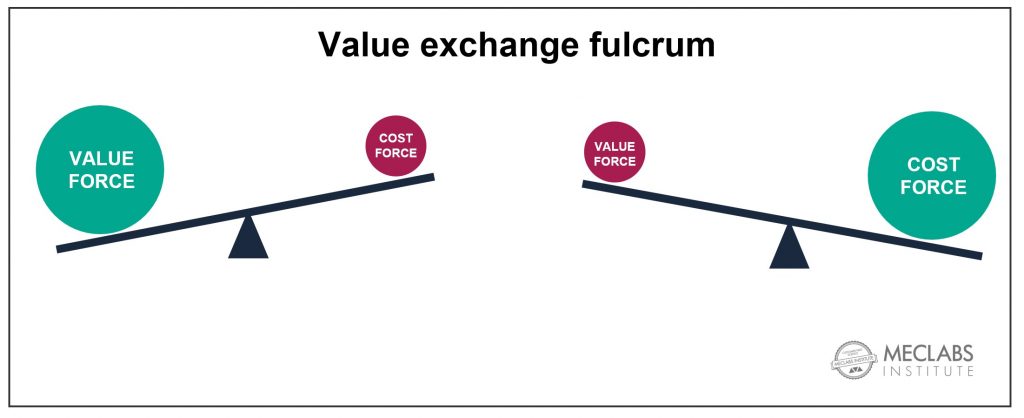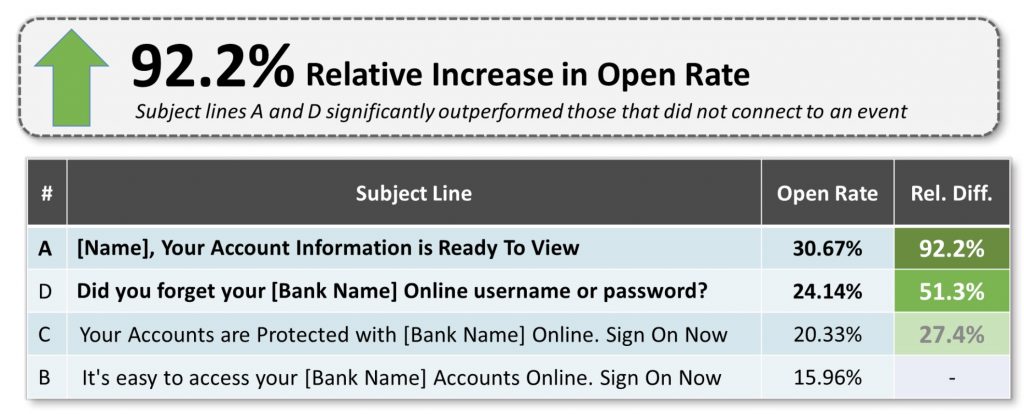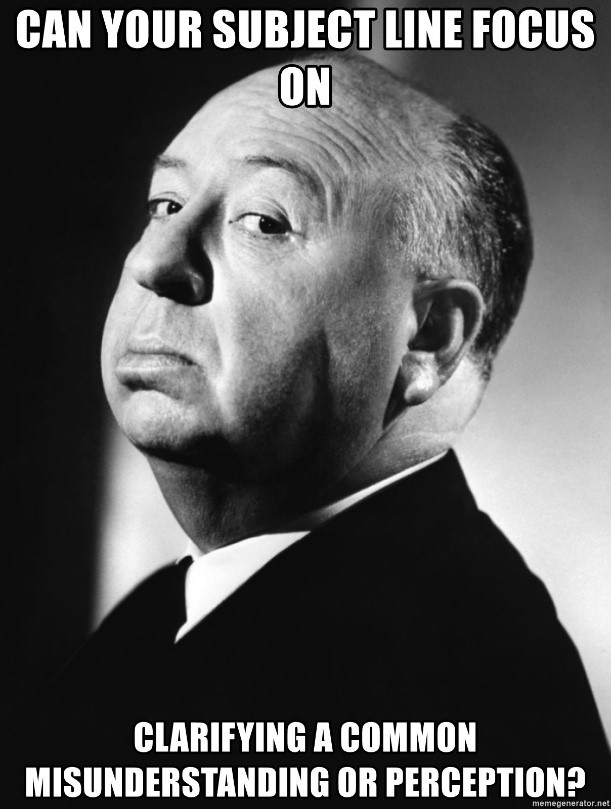https://static.addtoany.com/buttons/favicon.png [ad_1]
The Radicati Group predicted that the average business user would receive 97 emails per day in 2018.
97 emails per day.
So why should they open yours?
To help you optimize your open rate, we’re giving you a nine-point checklist for minimizing the perceived cost of the email open. This checklist is from the Email Messaging online certification course taught by MECLABS Institute (MarketingSherpa’s parent research organization).
You can click here to download a PDF of the Email Open Cost Force Checklist (no form fill required, instant download), and I will walk through the checklist step-by-step in this blog post.
EMAIL OPEN COST FORCE
For macro decisions, like a purchase process, you likely spend significant time and resources ensuring that customers understand the value of the product.
However, it’s all too easy to overlook the smaller decisions your customers are taking every day — the micro-yes(s) — like email open.
Every decision you ask prospective customers to make has a perceived value to the customer as well as a perceived cost. The “force” of value or cost is a term designed to discuss the strength of the effect of those elements on the customer’s decision-making process.
Put simply, if the value force is stronger, your customer will take the action you are asking. If the cost force is stronger, your customer will not take the action.
Now, this isn’t the actual value or cost of an action. It is the perceived cost or value before customers take an action. After all, they don’t know what value they will really receive until they act.
This checklist will help you minimize the perceived cost of an email open to help you increase your brand’s email open rate. For a checklist that will help you maximize the perceived value of the email open, along with checklists to help you grow your email list and increase clickthrough rate, you can download this bundle of six email marketing checklists.
JUSTIFYING THE SEND
Can the subject line reference a recent action or behavior on any owned media (e.g., your website, ad space, social media)?
One of my favorite emails I personally get is from ChargePoint, a network of electric vehicle charging stations. Every time I charge my car, I get an email with a report of how many kWh of electricity my car received.
Not the typical email promotion, for sure.
But that’s the point.
Can you tie your subject line to a specific action that your prospects have taken? It could better serve them and reduce the perceived cost of opening. Because then the email is not about your brand, but is about them. And we all care about ourselves, let’s face it.
Does it have a customer serving tone?
Look through your inbox — there are the subject lines that expect something of you. There are subject lines that are clearly trying to sell you something. And then there are subject lines that seem like they are helping you.
For example, in an experiment with a MECLABS Research Partner, four subject lines were tested:
- [Name], Your Account Information is Ready To View
- It’s easy to access your [Bank Name] Accounts Online. Sign On Now
- Your Accounts are Protected with [Bank Name] Online. Sign On Now
- Did you forget your [Bank Name] Online username or password?
Subject line A received 92% more opens than subject line B.
And as you can see, subject line A takes a much more customer-serving approach — here is something that is ready for you — versus subject line B, which seems to sell recipients on a positive feature of the bank’s product.
Are there any words that seem ambiguous or full of hype?
Hype words scream a sales attempt. Again, it’s the feeling that the emailer wants something from you instead of the feeling that the emailer has something to give you. What type of subject line would you rather open?
Going back to the above experiment, the top-performing subject line was a clear statement of fact. The worst-performing subject line was trying to hype the easiness of the product.
For example, here’s a subject line to an email I received … “You’re Invited to a Webinar!”
First of all, I can guarantee you they were far more excited to invite me than I was to be invited. Not to brag, but I get invited to my share of webinars. Dozens of webinars. Dare I say, hundreds of webinars.
Hence the need for a less ambiguous subject line. I have no interest in going to, or even opening an email about, a generic webinar. But I’m interested in goals and pain points that are relevant to me. If they happen to be packaged in a webinar, I might make an exception.
Does it feel exclusive or unique to the customer?
The emails that we’re most likely to open are from actual people telling something only to us.
The emails you likely send are from a brand with thousands of subscribers.
True one-to-one emails aren’t always feasible. But when you can’t send them, how granularly can you segment to make that subject line as tailored as possible to the recipient? And relating back to one of the above questions, how specifically can you tie the email (perhaps because it was triggered by a user action) to something the recipient did?
Email started as a medium that was from a person and to a person. The closer you can get to that with your emails, the better.
Are the envelope fields specific enough?
In addition to the subject line, there is other information your recipient will see in their inbox — the from field — and usually some preview text (also known as a pre-header). These are known as envelope fields. Much like direct marketers know to use the outside of the envelope customers receive in the postal mail to encourage an open, you should use these envelope fields to encourage an email open.
Have you tested the from field? Perhaps you can have the email come from a specific person along with your brand name, and not just the brand? Again, email started as an inherently human-to-human communication medium.
The open is an action with an unsure result at the end of it, i.e., what’s in the email itself. The preview text gives, as the name suggests, a little peek into what the email contains. Think about what specific value you can add in that text to overcome the cost of opening the email. The email should have a reason for being sent, and that reason should be of benefit to the recipient.
CONNECTING TO A PROBLEM
Can it highlight a recent issue of interest or concern? (e.g., in the news, in their lives)
Try a subject line that leverages real-time marketing. Or customer behavior.
But keep all the other points from the checklist in mind as well. Done poorly, this can scream hype or ambiguity and seem like the subject line version of clickbait.
If you want your overall email to be successful, you need to connect real people to real value. Tricking them to open an email won’t help meet your ultimate marketing objectives.
Can it connect to a lack of time, money and/or help the customer is experiencing?
One way to reduce the perceived cost of opening an email is to tap deeply into some other cost the customer is experiencing.
Here’s a subject line that recently got me to open: 4 common frustrations with [name of enterprise software platform I’m using here].
Can it focus on aiding an inability or inadequacy in the customer?
Sometimes the perceived pain point lies within the customer themselves. If you can help me be a better father, a better writer, a better marketer or a better environmentalist, you’ve created an opening for my attention. Of course, the other elements need to apply as well. I’m very sensitive to clickbait that exploits my weaknesses, and your customer is as well.
Where does your audience think it falls short? And how can you help them improve?
Can it focus on clarifying a common misunderstanding or perception?
This is one of my favorites. You think it’s X. But it’s really Y. Some examples from our own content …
You think you should put the call-to-action above the fold, here’s why you shouldn’t.
You think short copy is best, but long landing pages can perform better.
You think responsive design will improve results, but it doesn’t always increase conversion.
I like to think of this as the Alfred Hitchcock of subject lines. There’s a plot twist.
You can follow Daniel Burstein, Senior Director, Content & Marketing, MarketingSherpa and MECLABS Institute, on Twitter @DanielBurstein.
Related Resources
Email Marketing: Bundle of 6 checklists to optimize your email marketing
Email Marketing: Factors that influence open rate
Infographic: Email open rates by time of day
Email Messaging Online Certification Course from MECLABS Institute — Learn to test and optimize your email campaigns with real case studies and proven techniques.
Categories: Email Marketing B2B marketing, Consumer Marketing, customer-centric, Email Marketing, Inbound Marketing, lead nurturing, marketing insights
[ad_2]
Read_more MMO mastermind






No comments:
Post a Comment